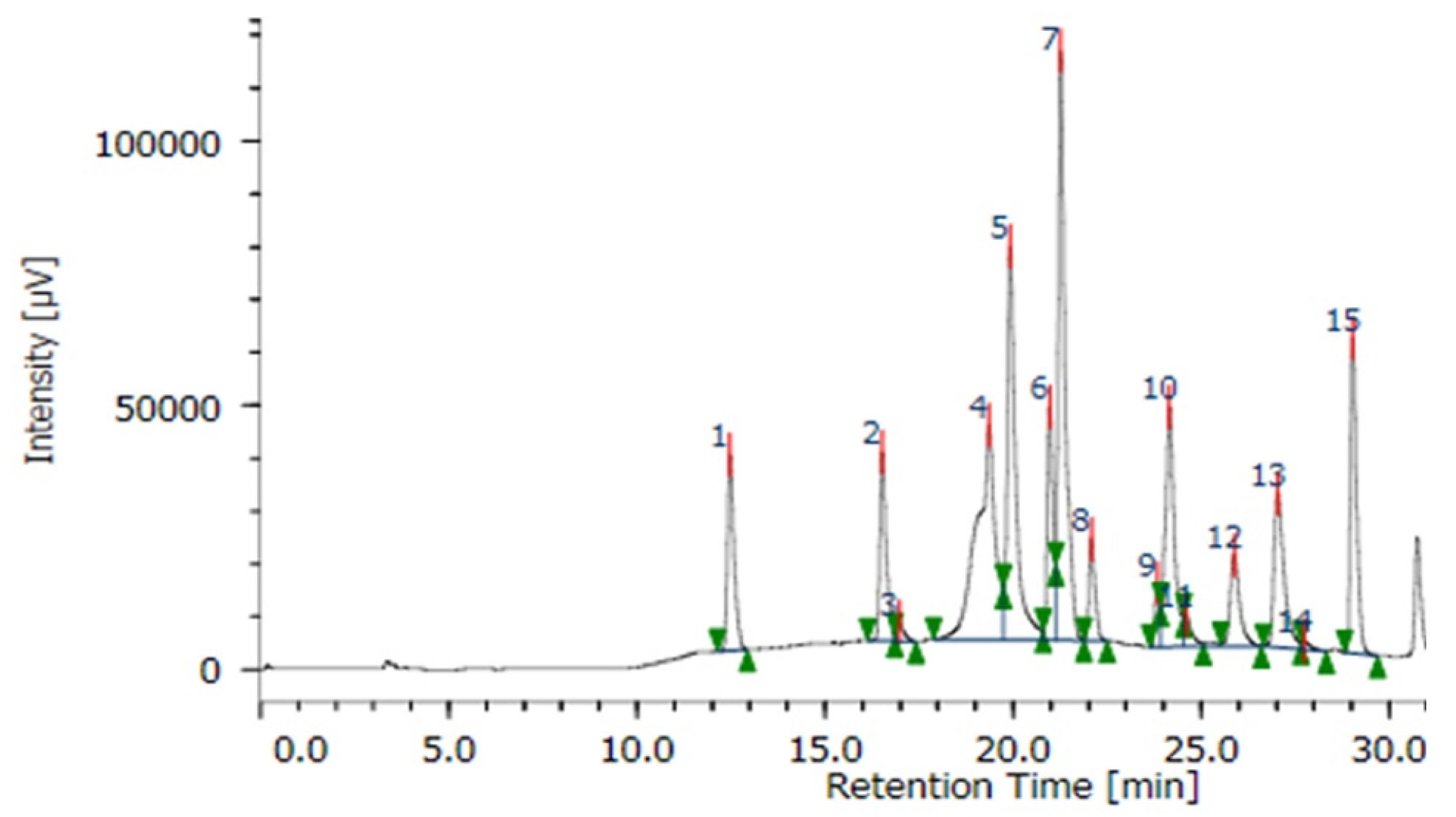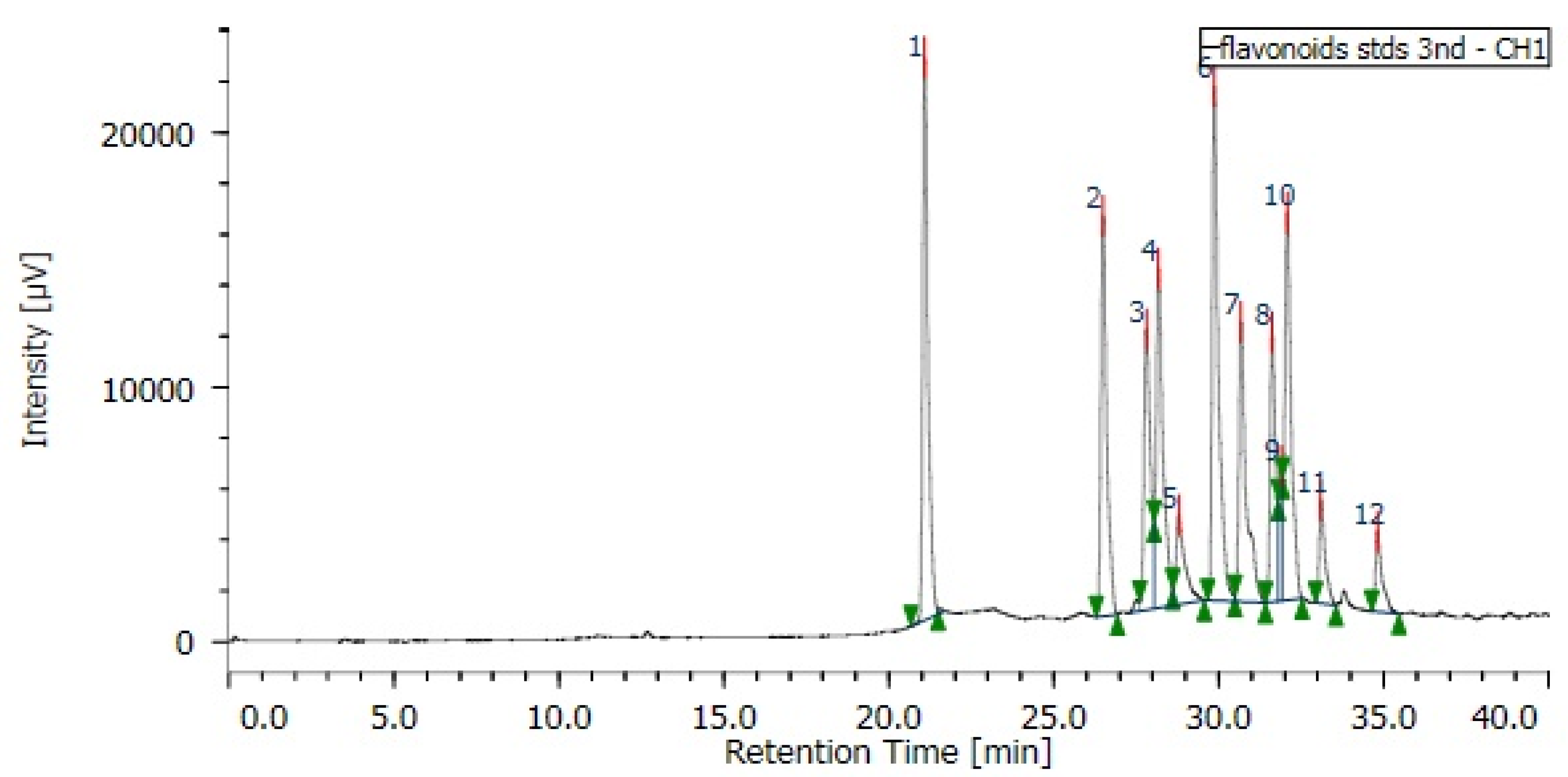1. Introduction
Edible vegetable oils are important sources of fatty acids (mainly unsaturated), which are predominantly triglycerides (95–98%), whist the remaining (5–2%) consists of complex mixtures of minor compounds such as sterols, triterpenic dialcohols, diglycerides, and squalene [
1,
2,
3,
4,
5]. Antioxidants and antibacterial activities are key agents for improving oxidative stability. Aluyor and Ori-Jesu [
6] noted that the shelf life of edible oils in food uses and their applicability in industry were greatly dependent on their oxidative stability and antibacterial activity.
Like humans, foods also need to be protected from oxidation. Foods in general have antioxidant additives to avoid lipid oxidation, which results in off-flavor development [
7,
8,
9,
10,
11,
12,
13]. As oxidation in foods is a chain process, a trace amount of antioxidant is required to suppress the process of oxidation [
14]. Reactive oxygen species (ROS) are formed during normal cellular metabolism, but they become toxic when present in high doses [
15]. Caponio et al. [
16] reported that polar substances such as triglyceride oligopolymers and oxidized triglycerides found in microwaved were higher in quantity than in conventionally heated olive oil.
In recent years, phenolic acids and flavonoids have been reported to contain multifunctional properties and beneficial effects on human health, among which polyphenols have attracted great attention [
17]. Edible oils contain a number of phenolic compounds, which contribute to oxidative stability, and may serve as antioxidants to reduce the stress of oxidation on human health [
18]. The DPPH (1,1-diphenyl-2-picrylhydrazyl) radical scavenging activity and
β-carotene bleaching methods are two of the most commonly methods used to determine antioxidant activities [
18]. Phenolic compounds have been known as potential agents for preventing and treating many oxidative stress-related diseases, such as cardiovascular disease, cancer, aging, diabetes mellitus, and neurodegenerative diseases [
19,
20].
Edible oils extracted from plant sources are important in foods and other industries [
21]. Oil extracts of sulfur-rich vegetables may have potent antimicrobial activity, and could be used in food preparation to get the synergistic effect of the oils and vegetables [
22].
S. aureus and
E. coli are the most common bacteria found in the environment and the human body, and are opportunistic pathogens that cause severe and life-threatening infections in immunocompromised patients [
21,
22]. Thus, the control of these two bacteria in the food industry is required.
Japan was ranked the eleventh-largest market of vegetable oils in 2016, with US
$1.51 billion worth of retail value sales. Between 2012 and 2016, the world vegetable oil products market grew at a compound annual growth rate (CAGR) of 8.16%, while that of Japan was 5.61% [
23]. A significant portion (41.3%) of edible oils sold in Japan in 2016 were coconut, grapeseed, groundnut, sesame, and blended oils [
23]. It is estimated that by 2021, the retail values of edible oils in Japan may reach US
$1.88 billion, and the growth of consumption rate in 2017–2021 is foreseen to be 4.3% CAGR [
23]. In this study, the selective criteria of the edible oils were based on their availability in markets. Extra virgin olive oil was not selected because it was not obtainable where samples were collected.
In this study, the antioxidant activity of the fourteen vegetable edible oils marketed in Japan by the DPPH radical scavenging activity and the β-carotene bleaching method were examined. Total contents of phenolics and flavonoids, as well as individual phenolic acids and flavonoids were analyzed and quantified by HPLC. The antimicrobial activity on the growth of S. aureus and E. coli in laboratorial bioassays were also evaluated. This study aimed to provide information for customers in Japan to have more choices on selection of edible oils available on the markets.
4. Discussion
The results showed that the highest amount of total phenolics was in the flax seed oil extract (39.16 mg/g) and was significantly higher than all of other edible oils. Anwar and Przybylski [
31] determined a lower content of total phenolics of 27 mg/g in flax seeds. The reason for the different results might be due to a difference in the varieties of flax seeds, extraction solvent, temperature, and equipment [
32]. Even if the total phenolic content of flaxseed oil extract was remarkably greater than other edible oils, the IC
50 of flax seed oil of the DPPH scavenging activity showed a low level at 2.396 mg/mL, and the
β-carotene bleaching value were significantly higher than the other oils (
Table 2), indicating that total phenolics in flax seed oil was not proportional to its antioxidant activity. The antioxidant activity of plant extracts may relate to the presence of some individual phenolic compounds [
33]. Inca inchi oil extract showed the maximum amount of total flavonoids (0.34 mg/g); however, the IC
50 of the DPPH radical scavenging activity of this oil was 0.430 ± 0.007 mg/mL—lower than sunflower, safflower, canola, soybean, and cotton (
Table 2). The lowest values of TFC were in safflower and soybean (0.03 mg RE/g oil extract) (
Table 3).
Sunflower oil extract gave the best results in the DPPH radical scavenging test, and similar capacity in the
β-carotene bleaching assay as compared with other oils, except avocado and chia (
Table 2). Among dietary plant sources, sunflower seeds are characterized by high antioxidant activity [
33]. This oil is shown to have low total phenolic and total flavonoid contents, but the flavonoid compound fisetin was found only in sunflower oil extract. Further, esculetin, isoquercetin, and kaempferol were also identified in sunflower oil extracts and the total amount of the identified individual flavonoids (IF) was higher than other oils, except grape and perilla (
Table 5). In addition,
p-coumaric acid was found in much higher quantity in sunflower than other oils. As a result, fisetin, esculetin, isoquercetin, kaempferol, and
p-coumaric acid might play an important role in the antioxidant activity of sunflower seed oil. Karamac et al. [
33] reported that sunflower seed is an important butyraceous source grown in many countries, particularly in many European countries, to provide rich antioxidants.
Bail et al. [
34] reported that the TPC of grape seed levels was at 70 ± 1.76 μg/g, and Doshi [
35] revealed that the TPC of two grape varieties Navarang and Merlot were 65.8 and 41.7 mg/mL, respectively, which was higher than the TPC of grape seed oil examined in this study (15.56 ± 0.24 mg/g). The TPC of grape seed was 20.02 mg/g, and suggested that it might be affected by varieties and extracting protocols [
36]. The
β-carotene bleaching method is based on the loss of yellow color of
β-carotene because the free radical produced from linoleic acid is able to strongly destroy unsaturated
β-carotene [
37]. In this study, grape seed oil extracts were shown to be the most potent in the
β-carotene bleaching assay compared to the other edible oils (
Table 2). Among the identified phenolic acids, benzoic acid and vanillic acid were observed as the major phenolic compounds, and esculetin, isoquercetin, myricetin, luteolin, and kaempferol were the principal flavonoids in most edible oils. Benzoic acid is extensively used in preservatives, flavor enhancers, analgesics, antiseptics, and chemotherapeutics. Fisetin was found in sunflower (
Table 5), while sinapic acid was detected only in cotton and perilla (
Table 4).
The antimicrobial activity of the edible oils was examined on two common bacteria—
S. aureus and
E. coli. The results demonstrated that all of the oils possessed antimicrobial activity on both
S. aureus and
E. coli (
Table 6). Friedman et al. [
38] reported that edible oils were widely accepted because they possessed unimaginable medicinal and pharmaceuticals properties, such as antimicrobial activity that could be employed against human pathogens. Rice bran possessed many bioactive compounds [
39]. In this study, rice bran showed the highest activity on
S. aureus. Moreover, the antibacterial activity of avocado oil extract was the strongest against
E. coli. Neeman [
40] reported that avocado possessed metabolites with antibacterial activity such as 1,2,4-trihydroxy-n-heptadeca-16-en that was extracted from avocado fruit and seeds. Other studies noted that avocado exerted strong antimicrobial activity, including the defensin PaDef which has a
γ-core motif, which was also important for structure stabilization [
41,
42]. Furthermore, tannins, catechin flavones, and polyphenolics in seeds and immature fruits of avocado may also play a role in the antimicrobial activity [
43].
The consumption of edible oils in Japan is increasing [
23]; hence, the findings of this study provide useful information on the antioxidant and antimicrobial properties of the most available essential oils in Japanese markets. However, further analyses should be carried out by widening the sample collection and analyzing oils produced in controlled conditions (i.e., in laboratory) so as to eliminate the influence of different processing conditions, which might affect the results obtained in this study. Useful information on the antioxidant and antimicrobial properties, as well as chemical profiles, may help customers to have more choices in the consumption of the edible oils in Japan’s markets.










